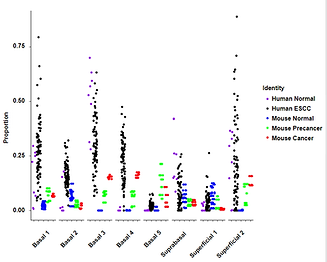WHELAN LAB
FELS INSTITUTE OF CANCER RESEARCH AND MOLECULAR BIOLOGY
AT TEMPLE UNIVERSITY
ESOPHAGEAL BIOLOGY
Our research in esophageal biology seeks to thoroughly characterize the processes of epithelial differentiation, autophagy, and aging.



TRANSCRIPTOMIC HETEROGENEITY OF THE ESOPHAGEAL EPITHELIUM AT SINGLE CELL RESOLUTION
Fluorescent staining of basal (red) and superficial (green) epithelial cells with Krt5 and Krtdap, respectively, to validate markers found by single-cell analysis.
THE FUNCTIONAL ROLE OF AUTOPHAGY IN REGULATING STEM-LIKE PROPERTIES IN ESOPHAGEAL BASAL CELLS
To define how autophagy relates to basal cell stem capacity, we sorted esophageal basal cells based upon their intracellular autophagic vesicle (AV) content using the AV-identifying dye Cyto-ID for subsequent 3D esophageal organoid formation and self-renewal assays.
ROLES FOR MITOCHONDRIA IN ESOPHAGEAL TISSUE AGING
A comparison of aged and young murine esophageal epithelium shows elevated expression of a group of mitochondria-related genes.
ESOPHAGEAL PATHOLOGIES
Eosiniphilic esophagitis (EoE) and esophageal squamous cell carcinoma (ESCC) are some of the most pervasive pathologies in the esophagus, and our research employs biological and computational models to further study them.



ALTERATIONS IN MITOCHONDRIAL BIOLOGY IN EOE
To assess the impact of the EoE inflammatory milieu on mitochondria, esophageal keratinocytes were treated with IL-13 and mitochondria were stained (green).
CROSS-SPECIES IMPUTATION OF MURINE ESCC CELL POPULATIONS IN HUMAN DATA
Combining the cell types found in murine ESCC using single-cell sequencing and human data from public repositories, a cross-species imputation was performed to compare the similarities and differences of cell type representation between humans and mice.
EVALUATION OF MITOCHONDRIAL DNA AS A NOVEL NONINVASIVE BIOMARKER FOR EOE
Assessment of mitochondria gene copy number in serum of human subjects with inactive EoE, active EoE, or gastroesophageal reflux disease to determine if the diagnostic utility of circulating mitochondrial DNA.